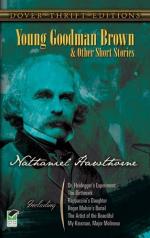|
This section contains 2,576 words (approx. 9 pages at 300 words per page) |

|
SOURCE: "The Vision of Goodman Brown: A Source and Interpretation," in American Literature, Vol. XXXV, No. 2, May, 1963, pp. 218-25.
In the following essay, Robinson posits that it is Goodman Brown's marital experience that has opened his eyes to the existence of evil
Students of "Young Goodman Brown" agree in general that its main materials are drawn from Cotton Mather's The Wonders of the Invisible World, published the year following the Salem witchcraft trials, in which Mather describes the devil's appearing as a "small black man" to lure people to forest rendezvous where church sacraments were imitated and mocked. Hawthorne, indeed, virtually quotes Mather in placing Martha Carrier among the witches as a "rampant hag" and promised "queen of hell." I have found, however, no comment upon Hawthorne's possible use of a passage from Mather's Magnolia Christi Americana (1702) as a secondary source. The Puritan historian recalls Governor Winthrop's 1632 visit...
|
This section contains 2,576 words (approx. 9 pages at 300 words per page) |

|


